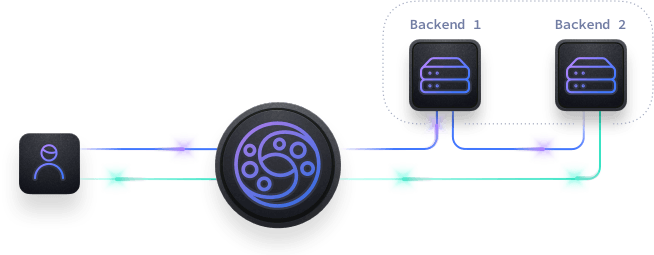Document updated on Nov 24, 2022
Sequential Proxy

The best experience consumers can have with KrakenD API is by letting the system fetch all the data from the different backends concurrently at the same time. However, there are times when you need to delay a backend call until you can inject as input the result of a previous call.
The sequential proxy allows you to chain backend requests.
Making use of sequential calls is considered an anti-pattern. This is because when you make a service dependent on the other, you are increasing the latency of the service, decreasing its performance, and augmenting its error rate.
For instance, if you have three backends with an error rate of 10% each when calling them in series, it produces an error rate of 27%.
Chaining the requests
All you need to enable the sequential proxy is add in the endpoint definition the following configuration:
{
"endpoint": "/hotels/{id}",
"extra_config": {
"proxy": {
"sequential": true
}
}
}
When the sequential proxy is enabled, the url_pattern of every backend can use a new variable that references the response of a previous API call. The variable has the following construction:
{resp0_XXXX}
Where 0 is the index of the specific backend you want to access (0 is the first backend), and where XXXX is the attribute name you want to inject from the response of the previous call. You can access nested objects of the response using the dot notation, for example {resp0_user.hash} will retrieve the value abcdef from the response {"user": { "hash": "abcdef }}. You cannot access nested objects inside arrays or collections, they must be objects.
GET), they can only be placed in the last position of the sequence. Sequences are meant to be used in read-only operations except for the last call. A sequence is not meant to be used in distributed transactions.Example
It’s easier to understand with the example of the graph:

The user calls the gateway with an URL like /hotel-destinations/{id}, which needs to fetch the hotel information and all its associated destinations. Let’s say the ID they request is 25. The gateway calls a backend /hotels/25 that returns data for the requested hotel, including a destination_id field that is a relationship identifier. The output for GET /hotels/25 is like the following:
{
"hotel_id": 25,
"name": "Hotel California",
"destination_id": 1034
}
KrakenD waits for the backend response and injects the value of destination_id in the URL of the next backend call. In this case, the next call is GET /destinations/1034, and the response is:
{
"destination_id": 1034,
"destinations": [
"LAX",
"SFO",
"OAK"
]
}
Now KrakenD has both responses from the backends and can merge the data, returning the following aggregated object to the user:
{
"hotel_id": 25,
"name": "Hotel California",
"destination_id": 1034,
"destinations": [
"LAX",
"SFO",
"OAK"
]
}
The configuration needed for this example is:
{
"endpoint": "/hotel-destinations/{id}",
"backend": [
{
"@comment": "This is the index position 0",
"host": [
"https://hotels.api"
],
"url_pattern": "/hotels/{id}"
},
{
"@comment": "This is the index position 1",
"host": [
"https://destinations.api"
],
"@comment2": "resp0_ is the response of index position 0",
"url_pattern": "/destinations/{resp0_destination_id}"
}
],
"extra_config": {
"proxy": {
"sequential": true
}
}
}
The key here is the variable {resp0_destination_id} that refers to destination_id for the backend with index 0 (first in the list).
